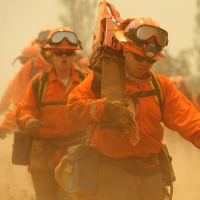State Inmates Paid $2 a Day to Fight Wildfires
 Calfornia inmate firefighters 2008 (photo: Ron Lewis, Associated Press)
Calfornia inmate firefighters 2008 (photo: Ron Lewis, Associated Press)
With wildfire season here, California taxpayers will be glad to know that they’ve got a hard-working corps of firefighters they can call on day or night, who don’t take vacations and work cheap. Really cheap.
California employs about 4,000 inmate firefighters. They’re “low-level” offenders who earn $2 a day in canteen credits, as well as two days off their sentences for each day they spend at fire camps. In the process, they save the state about $100 million a year, according to the California Department of Corrections and Rehabilitation (CDCR), because civilians are paid more than five times as much.
Although fighting fires is hardly akin to working on a chain gang, human rights observers question where the line lies between rehabilitating prisoners through meaningful work opportunities and exploiting cheap labor sources. Prisoners across the country, in public and private prisons, are employed in a wide range of work for little pay under less-than-fully-voluntary conditions.
Governor Jerry Brown declared a state of emergency on Saturday, as more than a dozen wildfires burn throughout the state. At one point half the crews fighting the Bully Fire near Ono were inmates. The crews usually consist of around 16 inmates and are trained and headed by a professional firefighter.
There are no figures on recidivism, but prison officials say anecdotally that they don’t see as many inmate firefighters return to prison as those from other programs or from no program at all. Around 3-5% of released inmate firefighters get jobs with the Department of Forestry and Fire Protection (CalFire) or private crews, according to the CDCR.
The inmates are under guard at their base camps, but there’s no barbed wire or guns. The inmates are treated more like firefighters than prisoners. “There’s an assembly where we have a formation in the mornings and it was like my second or third day and the lieutenant comes out and he goes, ‘Look, we’ll treat you like men first, firefighters second and prisoners if we have to,’ ” inmate Cory Sills told KQED. “That right there, that stuck in my head for two years now because now I have a chance to be treated like a man.”
Or like a woman. There are also female inmates in the program. They, like the men, must be able to carry large amounts of equipment and personal supplies onto a fire line and clear brush and perform other chores in brutal heat.
“You learn a lot about yourself,” said Michael Dignan, who has been an inmate firefighter for four years. “You learn that there is stuff you can put yourself through that you never thought you would have been able to do.”
–Steve Straehley
To Learn More:
California Leans Heavily on Thousands of Inmate Firefighters (by Alex Helmick, KQED)
For $2 a Day, Female Inmates Help Douse Trail Fire (by Ken Stone, Times of San Diego)
California Department of Corrections and Rehabilitation (CDCR)
Battling California Fires, Inmates Find a Chance at Better Role (by Ben Arnoldy, Christian Science Monitor)
California Relies on Thousands of Inmates Paid Dollars a Day to Fight Raging Wildfires (by Scott Kaufman, Raw Story)
The Prison Industry in the United States: Big Business or a New Form of Slavery? (by Vicky Pelaez, Global Research)
- Top Stories
- Controversies
- Where is the Money Going?
- California and the Nation
- Appointments and Resignations
- Unusual News
- Latest News
- California Forbids U.S. Immigration Agents from Pretending to be Police
- California Lawmakers Urged to Strip “Self-Dealing” Tax Board of Its Duties
- Big Oil’s Grip on California
- Santa Cruz Police See Homeland Security Betrayal in Use of Gang Roundup as Cover for Immigration Raid
- Oil Companies Face Deadline to Stop Polluting California Groundwater





